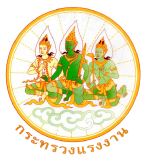The Immigration Bureau, Japanese Ministry of Justice, reported an initial report on the number of foreigners registered as residing in Japan as at the end of June 2011, compared with that as at the end of March 2011 after the earthquake and Tsunami in the Northeastern region on 11 March 2011, as follows:
1. At the beginning of 2011, the number of foreigners registered as residing in Japan was 2,134,151 persons in total. But after the earthquake and Tsunami, at the end of March 2011, there was 1.9% decline in the number of foreigners, to 2,092,944 persons. After that the number has slightly increased, 994 persons, to be 2,093,938 persons as at the end of June 2011.
2. As at the beginning of 2011, there were foreigners from 191 countries residing in Japan. After the earthquake and Tsunami, at the end of March 2011, the number of countries has decreased to 148 countries. As at the end of June 2011, the number of foreigners from 89 countries has increased.
3. Based on the nationality of foreigners in Japan: The number of foreigners of those countries having more than 50,000 persons living in Japan (i.e. China, Korea, Brazil, the Philippines, and Peru) has decreased after the earthquake at the end of March 2011. As at the end of June 2011, only the number of those from China and the Philippines has slightly increased, the number of those from other countries has slightly decreased.
4. Based on the status of residence (visa): As at the end of March 2011 after the earthquake, the number of foreign trainees (short-term) and students has sharply decreased i.e. 55.5% and 10% decrease respectively. However as at the end of June 2011, the number of foreign students has slightly increased (2.1%), while the number of trainees (short-term) still in decline for another 19.7% from March. The number of those holding visa for technical traineeship has risen constantly, 23.1% increase from the beginning of the year to March 2011, and 15.7% increase from March to June 2011.
As for other types of visa, there has been no obvious increase or decline. Those with slight decrease are Japanese spouse, long-term residents, special permanent residents, engineers, those who work in a foreign company branch, and those who work in the field of education. Those with slight increase are ordinary permanent residents, family dependents, those with knowledge in the field of humanity / foreign affairs, skilled workers, spouse of permanent residents, investors / executives.
5. Based on residential area: As at the end of March 2011, the number of those living in top 10 foreigner residential areas (71.8% of the total number) has all declined. However as at the end of June 2011, the number of those living in Tokyo, Osaka, Kanagawa, Chiba, and Fukuoka has recovered and slightly increased, while the number of those living in other areas is still in continuous decline. Considering every area of Japan, it is found that there are 24 areas from 47 areas in which the number of foreigners increased as at the end of June 2011.
6. Considering only 5 areas which were most affected by the earthquake and Tsunami i.e. Aomori, Iwate, Miyagi, Fukushima, and Ibaraki: As at the beginning of 2011, there were 92,519 foreigners living in the areas, accounting for 4.3% of the total number (Tokyo accounts for 19.6% of the total number). This number decreased 7.8% as at the end of March 2011. Iwate is the area with the highest rate of decline i.e. 15.1%, the second is Miyagi with 9.9% decline, Fukushima with 8.9% decline, Ibaraki with 6.3% decline, and Aomori with 5.4% decline.
As at the end of June 2011, the number of foreigners in the said 5 areas is still in decline for another 0.8% compared to the number in March 2011. Fukushima, Miyagi, and Iwate have seen 3.9%, 3.4%, and 1.0% decrease respectively. Ibaraki and Aomori have seen 0.5% and 0.1% increase respectively.
Considering the types of visa of foreigners residing in the said 5 areas as at the end of June 2011, it is found that the number of trainees (short-term) has decreased 63.8% from the beginning of 2011. Foreign students comes at the second place with 8.0% decrease, long-term residents with 4.2 decrease, and Japanese spouse with 2.9% decrease respectively. The number of those holding a visa of technical trainee has increased 42.5%, those with knowledge in the field of humanity / foreign affairs with 3.1% increase, long-term residents with 2.8% increase, and dependents with 1.5% increase respectively. Other types of visa have seen a slight decline in number.





